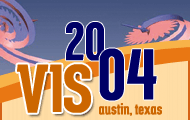 |
| VIS SESSIONS | ||||||||||||||||||||||||||||||
| |
Tutorials Sunday This tutorial will provide the necessary background to understand the issues in the development and usage of visualization integrated with data mining and knowledge discovery systems. We will provide a brief history of data visualization and data mining and examine both sample commercial and academic knowledge discovery systems that integrate visualization and data mining. Many slides, videotapes and demonstrations will be provided.
Tutorial 2 (Full
day) Procedural encoding of scattered data sets is an active area of research with great potential for reconstructing surface information and compactly representing large data. The reduced storage requirements allow greater flexibility in the methods for manipulating and analyzing this data interactively. In this course, we will cover both the mathematical foundations behind existing encoding techniques, surface reconstruction methods, and volumetric representations. Additionally, we will present methods for feature analysis in the functional domain and conclude with applications and benefits of functional encoding in the scientific and engineering disciplines.
Monday In the last three years, commodity graphics processors (GPUs) have evolved from fixed-function graphics units into powerful data-parallel processors. These streaming processors are capable of sustaining computation rates of greater than ten times that of a single CPU. Researchers in the evolving field of general-purpose computation on graphics processors (GPGPU) have demonstrated mappings to these processors for a wide range of computationally intensive tasks. Examples in the visualization domain include ray tracing, partial differential equation solving, 2D and 3D image processing, and surface processing. This tutorial provides a detailed introduction and overview of the GPGPU field to the visualization community. Attendees will gain an understanding of modern GPU architecture, the GPGPU programming model, and the techniques and tools required to apply GPUs to their own applications.
Tutorial 4 (Full
day) Virtual endoscopy, surgery simulation, soft-tissue simulation MRI motion capture, functional MRI are among the most actively researched topics in virtual medicine and medical-imaging. Both focus on the simulation of medical procedures for training, planning, diagnosis, and prognosis without requiring an invasive intervention. This course covers concepts that are used in research as well as in production systems.
Tuesday Tutorial 5 (Full
day) This tutorial is designed to introduce attendees to the most common visualization techniques and provide concrete examples of these techniques using The Visualization Toolkit. It is designed for attendees who have some programming knowledge but are not experts in the field of visualization. The focus will be on geometric, scalar, and vector field visualization using techniques such as iso-surfacing, direct volume rendering, streamlines, scalar coloring, glyphing, and image processing.
Tutorial 6 (half
day, morning) Interactive texture-based flow visualization has become an active field of research in the last three or four years. Recent progress in this field has led to efficient vector field visualization methods and, in particular, to improved techniques for time-dependent data. This tutorial covers approaches for vector fields given on 2D planes, on surfaces, and within 3D volumes. Both the theoretical background and the GPU-oriented implementations of many of these techniques are presented, along with a demonstration of their usefulness by means of typical applications.
Tutorial 7 (half
day, afternoon) Flow visualization is one of the major topics of this conference since its very beginning. It has shown a fast development over years and triggered new techniques like texture-based methods and feature detection. This tutorial will focus on the last trend and analyze new techniques as well as open questions like vague feature definitions and the dependence on the user. Some of the new developments are: evaluation of detected features to rule out false positives, interactive definition of features supported by information visualization methods like linked views and focus+context visualization, transfer of image processing to vector data, and new topology-oriented algorithms.
|
|||||||||||||||||||||||||||||